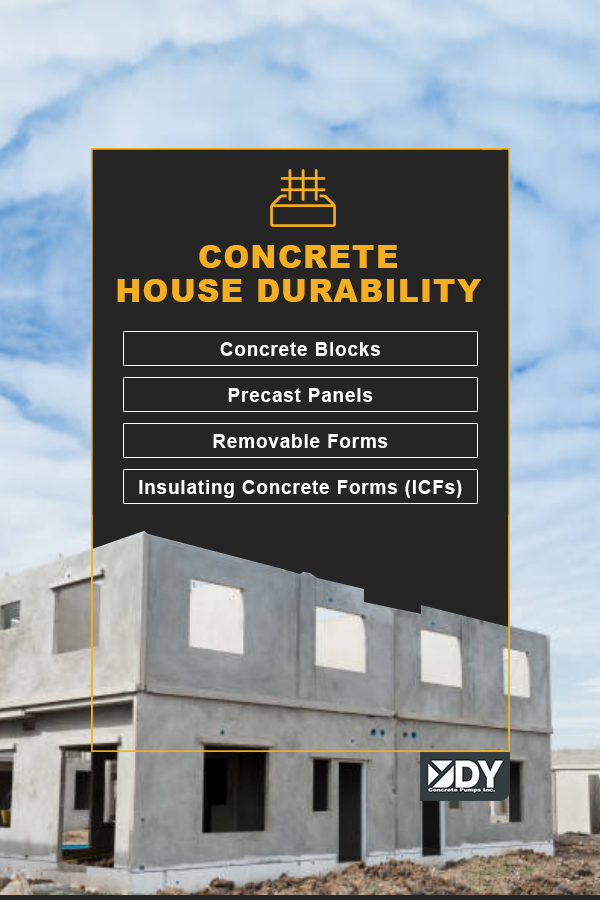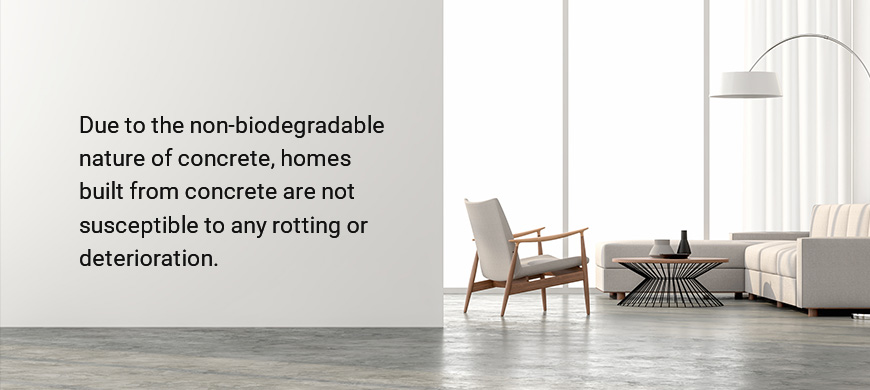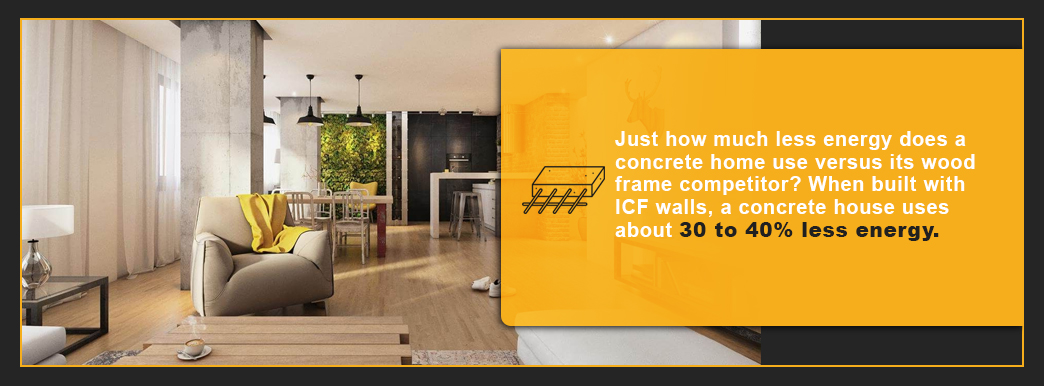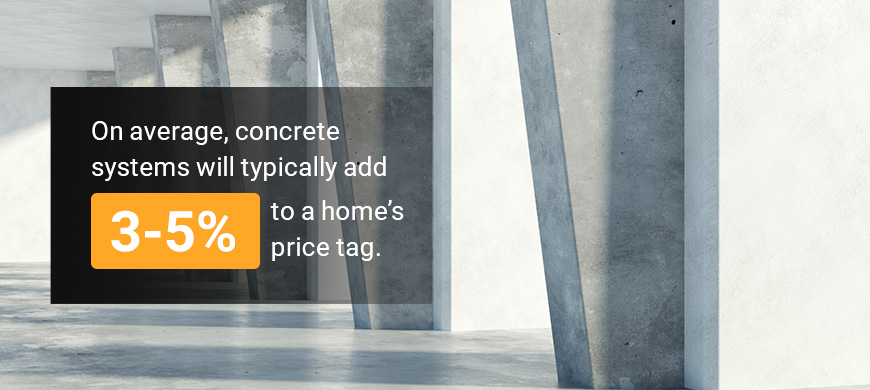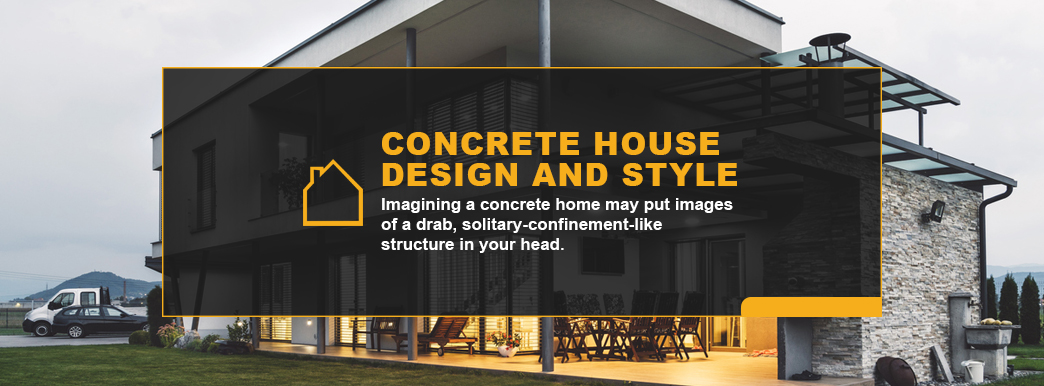
The Pros and Cons of Concrete Houses
Posted By:Dynamic Concrete Pumping , Date: May 27, 2020
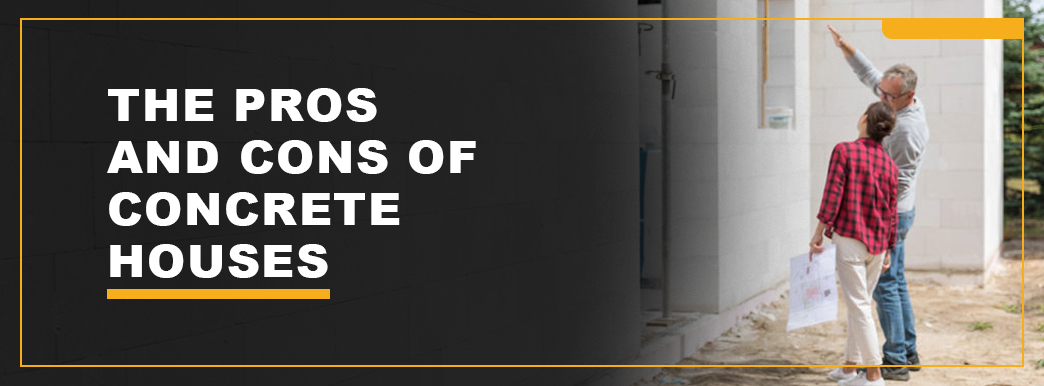
-Updated 4/21/23
The benefits of a concrete house make it an incredible investment for any family. A concrete home provides comfort, increased durability, longevity, enhanced safety, reduced outside noise and energy savings. A concrete home is also an aesthetically-pleasing option because homeowners can customize their home design to fit their preferred style.
What Are the Pros and Cons of Concrete Homes?
Concrete homes, known for their long-lasting, energy-conserving and cost-saving abilities, are gaining more and more popularity across the housing market. While you might consider concrete non-conventional compared to more traditional construction materials, concrete remains a top competitor in the eyes of homeowners with minimal drawbacks.
Some benefits of concrete buildings include:
- Ability to withstand exposure to the elements
- Significantly longer life expectancy than that of a wood or steel frame
- Insurance and energy cost savings
- Enhanced safety
- Various style options to create an aesthetically pleasing appearance
- Noise reduction
The only two disadvantages of concrete houses are the following:
- Higher initial cost
- Fewer construction companies with the resources to construct concrete houses
The growing popularity of concrete homes shows concrete is at the top of the ranks over other construction materials, such as steel or wood. Before purchasing your next home, consider the pros and cons of concrete houses.
Concrete House Durability
One of the greatest benefits of concrete homes is their durability. As a homeowner, you want a house that is here to stay. Concrete structures can remain standing for centuries, and concrete homes will typically outlast ones built from wood or steel frames. Before purchasing a concrete house, you should familiarize yourself with the four main types of concrete homes and how they rank in terms of durability. The four types of concrete house construction are concrete blocks, precast panels, removable forms and insulating concrete forms (ICFs).
1. Concrete Blocks
As one of the more affordable methods of building with concrete, precast concrete blocks are produced with speed and ease. Although some think concrete blocks are all the same size and shape, concrete blocks can vary and be used with facings or coverings to create eye-catching home designs. Manufacturers produce precast concrete blocks and transport them to application sites for assembly.
2. Precast Panels
Precast panels are produced at a concrete plant and are the exterior walls of a home that also feature installed foam insulation, embedded steel reinforcements and electric wiring. Cranes take the panels and attach them to the foundation and the other panels which can make for quick building. Precast panels can have a higher cost than some of the other concrete building options, but they remain durable — specifically against wind conditions.
3. Removable Forms
Removable forms place insulation and reinforcing steel in aluminum, wood or steel removable wall forms. After the concrete poured into the forms has cured, these wall forms are then removed. With removable forms, exterior and interior walls can be poured at the same time, which can certainly speed up construction time on a new home. Because they offer numerous insulation methods, removable forms are a conventional concrete option that is sure to stand strong.
4. Insulating Concrete Forms (ICFs)
Perhaps the most popular and one of the most durable methods of concrete construction, insulating concrete forms (ICFs) are made of extremely dense plastic foam and filled with concrete and steel reinforcement. Once filled, ICFs create a highly-insulated, airtight thermal sandwich that can withstand fire and high winds.
The steel reinforcement used in ICFs is buried in concrete, protecting it from corrosion and rust. The plastic foams are treated with flame retardants to prevent them from burning in the case of a fire. This combination of materials creates an extremely durable structure.
contact Dynamic Concrete Pumping
Enhanced Safety in Concrete Homes
Regardless of the method, concrete homes provide homeowners with increased protection against elements such as wind and fire. This protection is significant — ICF walls can protect homeowners from debris as a result of a tornado or hurricane with wind speeds up to 250 mph. With a home constructed of solid concrete, you can protect yourself against the most unthinkable circumstances.
According to the National Fire Protection Association, a house fire occurred every 23 seconds in the U.S. in 2021. Concrete is a fire-resistant material that protects structures from fire damage and slows the spread of flames, making it easier for families to evacuate their homes in the event of a fire.
Concrete can withstand high heat, and increasing temperatures degrade its strength slower than other materials. Flames are slower to spread to other rooms in a concrete home because concrete walls separate fire-affected areas from nearby spaces.
If a family experiences a house fire in a concrete home, they can expect their home to remain standing after the fire. While a wooden home would require extensive repairs or a total rebuild after a fire, a concrete home may only need appliance and furniture replacement.
Longevity and Damage Prevention
Due to the non-biodegradable nature of concrete, homes built from concrete are not susceptible to any rotting or deterioration. Homeowners no longer need to worry about wood rot or annoying termites.
While you can expect your concrete home to last centuries, the average life expectancy of a wood-frame house is 30 to 50 years on the low end. With a concrete house, homeowners can have peace of mind knowing their home will better withstand their worst nightmares when put up against concrete’s competitors. Concrete homes can also give homeowners reassurance in the area of energy conservation.
Energy Savings
Another benefit of a concrete house is its ability to save homeowners money.
Concrete — it’s solid, it’s sturdy, and it’s insulated. These properties make it a great option to stand strong and save some serious energy. As a homeowner, think about the benefits of airtight insulation when it comes to keeping cool in hot summers and staying warm in frigid winters.
Compared to a wood-frame house, air infiltration in a concrete home can be decreased by roughly 75% using the foam-and-concrete-formed barrier. With concrete, cold drafts are a thing of the past, and you can keep your home at a more consistent temperature.
1. Increase Thermal Resistance
For a typical ICF, the R-value is roughly 20. R-values, also referred to as thermal resistance, measure an insulating material’s ability to resist heat flow. The higher an R-value is, the better the insulation effectiveness. With airtight walls, a single-family ICF home can save a homeowner approximately 110 tons of carbon dioxide compared to a wood-frame home.
2. Go Green
As more emphasis is being put toward environmentally friendly initiatives, purchasing a concrete home could consider you an owner of a “green” — or environmentally friendly — home. To view your home a green one, it must conserve resources and maximize its performance while consuming low energy, water and natural resources.
Overall, these houses are healthier for the environment and those living in them. Since ICFs get the most out of energy, reduce occupants’ exposure to mold and mildew, minimize waste and conserve natural resources by using recycled materials, purchasing a concrete home could qualify you as a green homeowner.
Since it was introduced in Europe following World War II, concrete housing has gained popularity in North America — most recently, in Canada. In efforts to encourage the construction of more energy-efficient housing, the Canadian government launched programs highlighting the importance of conserving energy. These programs resulted in more ICF housing, surpassing concrete home growth in the U.S. and continuing to increase.
As the market for concrete housing has grown across the U.S. and Canada, homeowners can expect to see even more options in the coming years.
3. Cut Energy Costs
Just how much less energy does a concrete home use versus its wood frame competitor? When built with ICF walls, a concrete house uses about 30% to 40% less energy. As a homeowner, it’s reassuring to know your concrete home is using less energy. Perhaps even more reassuring that you made the right choice going for a concrete home is seeing your energy bill go down each month.
A concrete home will save you money and save you trips to the thermostat. Because concrete is a thermal mass material, it helps control the temperature of the home and keep it more uniform. In turn, this improvement in temperature could save you even more money by allowing you to use smaller HVAC equipment that could reduce construction costs by $500 to $2,000.
Switching over from traditional wood-frame housing is an excellent option for homeowners looking to save energy who want to see the direct results of doing so as shown on their cheaper electric bill each month. With more durability and energy efficiency than the traditional wood-framed counterpart, concrete homes are a clear winner. As a homeowner, you are likely wondering how much more money concrete homes will cost you. Before you compare price tags of concrete homes against the others, there are a few factors you must keep in mind.
Increased Comfort and Safety
Since concrete homes resist heat flow, they provide excellent insulation. Homeowners can expect to maintain comfortable temperatures year-round without constantly adjusting a thermostat or using significant amounts of energy.
Concrete homes also provide outside noise reduction. Concrete walls absorb sound wave energy and reflect noise toward its source. Very little sound energy travels through a concrete wall, keeping outside noise out of the home for a quiet, relaxing atmosphere.
Concrete homes allow families to enjoy peaceful times together without the noise of busy traffic or loud neighbors filling their houses. This is especially beneficial for individuals who work remotely or operate businesses from their homes. A concrete house can provide the perfect sound insulation for a home office.
Concrete House Costs
Concrete homes can withstand the unthinkable and conserve more energy, so it may not be surprising that the initial costs will almost always be higher than that of a home built from other construction materials. But just how much more will a concrete house cost?
1. Expect to Spend More Upfront on Concrete Housing
On average, concrete systems will typically add 3 to 5% to a home’s price tag. According to a study conducted by the U.S. Department of Housing and Urban Development (HUD), this equates to about $2 to $4 per square foot on average. The study shows that for a $180,000 two-story home with 2,500 square feet, the additional cost of a concrete home would result in an approximately $7,000 increase in price.
Homeowners may run into additional costs considering concrete’s increased weight and thicker walls in a home. These costs could be the result of things such as installation challenges or a longer list of requirements for the foundation since the building is more substantial than most homes from other materials, such as a wood-frame house. While these increases in price may seem significant to some homeowners, it’s essential to consider the cost savings not stated in the home’s price tag.
2. Save Money When It Comes to Durability
Since concrete homes are the undeniable winner when it comes to durability, you have to consider the money you will save on repairs and maintenance as a homeowner. For example, with a wood-framed home, you are more susceptible to degradation issues such as wood rot, mold or termites.
Wood rot could lead to structural problems such as destroyed roof decking or deteriorated support posts and beams. Repair costs for wood rot could cost homeowners up to tens of thousands of dollars. With a concrete home, this issue is nonexistent.
Owning a wood-framed home also puts homeowners at higher risk for mold, which many times goes undetected until the mold has already taken hold. Since concrete can’t absorb moisture, the chance for mold is extremely low and another potential cost out the window.
Termites are also one less worry with a concrete home. With a wood-framed house, termites can take hold and cost homeowners money. If the home has a large infestation that would require fumigation with tenting, homeowners can dish out anywhere from $1,200 to $2,500 or more. Insurance companies may cut costs on policies when considering these factors for homeowners who purchase a concrete home.
As concrete is being used to protect homeowners from the elements, it can also save you money when you consider fire, specifically. In 2017, the National Fire Protection Association estimated fires to have caused $23 billion in property damage.
Since concrete can burn longer before structural failure, concrete homes can save homeowners costs if the unthinkable would happen. Many insurance companies offer discounts for concrete homes and their ability to withstand natural disasters such as fires, hurricanes or earthquakes.
3. Save Money Through Lower Energy Bills
Since concrete homes conserve more energy, HUD reports homeowners can expect to save 20 to 25% in annual heating and cooling costs alone when put up against homes built from other traditional materials. For homeowners who choose to live in a concrete home long term, this cost savings can prove to be significant.
When having a concrete home built, homeowners may also opt to have smaller heating and cooling equipment installed which could save them hundreds or even thousands of dollars upfront. Homeowners who purchase a concrete home may even be able to qualify for an Energy Efficient Mortgage (EEM). These grant homeowners a larger mortgage and allow them to invest more money in a concrete home as a result of lower monthly heating and cooling bills.
While the initial purchase of a concrete home will likely be more expensive, the ongoing savings will more than make up for it. From insurance policy discounts to cheaper electric bills, the investment will prove to be worth every penny. In addition to durability, energy conservation and the opportunity to save money, homeowners should consider one last thing — style.
Concrete House Design and Style
Imagining a concrete home may put images of a drab, solitary-confinement-like structure in your head. However, you have probably seen concrete houses nearby without even realizing they are made of concrete. It’s time homeowners discover how aesthetically pleasing concrete homes can be. You can enjoy a durable, concrete structure without sacrificing a beautiful home appearance. Since concrete is easily molded, your home can be functional with a fresh appearance.
Because ICFs have nailing strips for interior and exterior finishes and treatments, you can personalize your concrete home by adding things such as siding, stone or brick. Foam forms in ICFs can be cut and shaped as you please, so concrete can provide architectural design customization that you wouldn’t be able to achieve with wood-framed construction.
When you choose a concrete home, you can choose from different overall style options ranging anywhere from industrial to Victorian. You can even customize house features such as high ceilings, custom angles and curved walls. One way to enhance a concrete home’s appearance and increase its curb appeal is to apply exterior siding.
The following are the most long-lasting siding options for concrete houses:
- Fiber cement: Fiber cement comes in a few different options and is known as one of the most durable forms of siding.
- Mortarless masonry: Mortarless masonry wall systems are supported by mortarless walls and sure to stand firm.
If you want a more eye-catching color, choose from the following siding options:
- Stucco: Stucco is known to be extremely colorful and unable to crack.
- Fiber cement lap: Fiber cement lap comes in many different shapes and colors.
- Shingle fiber cement: Shingle fiber cement is available in a wide array of colors and known to be very pretty.
You can also choose from the following siding options for a stunning appearance that will turn heads:
- Stone and brick veneers: Stone and brick veneers are both extremely beautiful and strong siding options.
- Sheet–form fiber cement: Sheet-form fiber cement is known for its good looks and ability to withstand warping and insect damage.
With the flexibility and options building a concrete home offers, you can dismiss any dull, preconceived notions and create a gorgeous home that meets all of your aesthetic requirements.
Concrete Home Construction
Not all companies have the knowledge and resources required for surface preparation and to construct a concrete home properly. While concrete is one of the best materials for new house construction, many homeowners avoid it because they don’t know where to look for help. Seeking help from professionals who have the knowledge and experience to work with concrete properly can help you construct the perfect home for you and your family.
Ask About Dynamic Concrete Pumping for Faster Concrete Construction
With their durability, ability to save energy and cost-saving properties, concrete houses are clearly superior to other home-building materials. If you are ready to take the next step and enjoy the benefits of a concrete home, consider working with an expert concrete contractor to construct your concrete house. Contact Dynamic Concrete Pumping to learn more about how our equipment and expert services can fast-track your concrete construction project.


